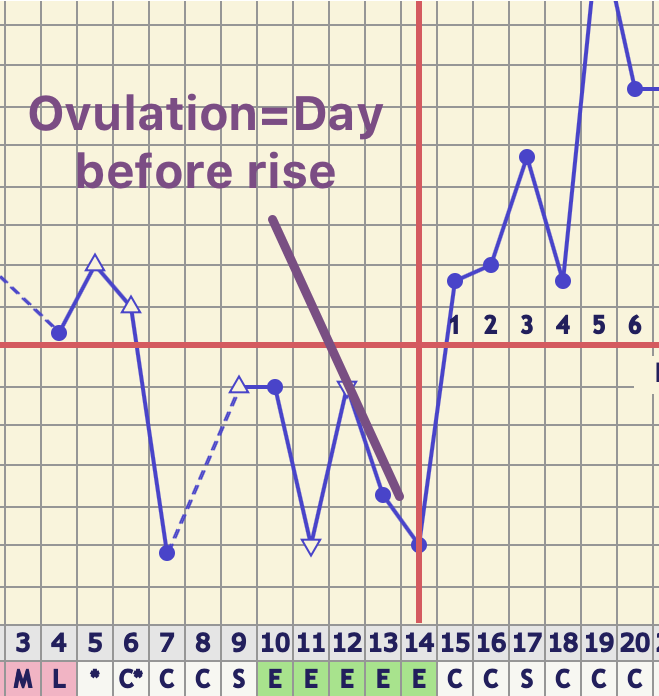All about Basal Body Temperature - BBT
Lesson 7
Lesson Objectives:
-
Understand the role of BBT in fertility charting
-
Learn how to use BBT to detect ovulation
Major Points in this Lesson:
-
Basal Body Temperature (BBT) is your body temperature at rest (wake up time).
-
BBT rises after ovulation due to increased progesterone released from the corpus luteum.
-
Ovulation can be detected on a fertility chart for the day before the temperature rises.
-
When ovulation is detected on a fertility chart, the chart shows a biphasic (lower temperatures followed by higher temperatures) pattern.
-
BBT stays in the higher range throughout the luteal (post-ovulation) phase until the next cycle begins.
-
BBT stays high if there is a pregnancy.
More...
After ovulation, the corpus luteum (the remains of the follicle that released an ovum at ovulation) produces the heat-inducing hormone, progesterone. The principal reproductive function of progesterone in the luteal phase is to cause changes that prepare the lining of the uterus for the implantation of a fertilized ovum. Progesterone also causes the resting body temperature to rise after ovulation. Because progesterone is only secreted in high levels after ovulation, it is possible to identify ovulation for the day before the temperature rises when temperatures are plotted on a graph.
To illustrate, see the image below. The blue dots represent daily temperature readings. Ovulation is identified by the vertical red line. The horizontal red line is a "coverline" to help to visualize the biphasic pattern.

Low temperatures are observed before ovulation and higher temperatures are recorded after ovulation.
Your BBT, or basal body temperature, is your body temperature at rest as measured in the morning after at least three hours of sleep, before you get up, with a special BBT thermometer available at drugstores. Some wearable devices are also able to measure temperatures that can be used for fertility charting.
Before ovulation, during your follicular phase, basal temperatures are relatively low. After ovulation, your basal body temperature rises sufficiently that you can see the difference between your pre-ovulation and post-ovulation temperatures when they are plotted on a graph.
A fertility chart that shows ovulation detected by BBT will have a biphasic pattern. This means that it will show lower temperatures before ovulation, a rise (thermal shift), and then higher temperatures after ovulation. Ovulation usually occurs on the last day of lower temperatures.
Your BBT corresponds to the heat-inducing hormone progesterone. This sign can confirm that ovulation actually happened. All the other signs only tell you that ovulation may be approaching.
Your temperature sign is the sign that will best help you to precisely pinpoint the day that ovulation occurred. This is because progesterone, and hence your temperature, increase quite dramatically just after ovulation has taken place.
Before ovulation, there is only a small amount of progesterone present in your body and your basal body temperatures (your resting temperatures) are in the lower range. After ovulation, when there is increased progesterone secreted from the corpus luteum, temperatures become elevated. The temperature elevation that occurs after ovulation is sufficient to be measured with a BBT thermometer and viewed on a BBT graph when a few simple conditions are met.
The rise in temperature is usually about 0.4 degrees Fahrenheit or 0.2 degrees Celsius, but the rise may be as slight as 0.2 degrees Fahrenheit or 0.1 degrees Celsius or even less in some cases. The actual temperatures are less important than noting a biphasic pattern showing two levels of temperatures. Your Fertility Friend application on your phone or computer will indicate that ovulation has taken place once a sustained temperature rise is observed (at least three days).
If there is no pregnancy, your temperature will stay elevated for 10-16 days, until the corpus luteum regresses. At this time, unless there is a pregnancy, progesterone levels drop dramatically and you get your period. Your temperature normally drops at this time as well, though it is not unusual to have erratic or high temperatures during your period.
While measuring your BBT can help to pinpoint or confirm ovulation, it is important to observe this sign in conjunction with other signs as well, particularly your cervical fluid. Observing multiple signs allows for cross-checking in the case that one sign is ambiguous or affected by other factors.
The temperature sign can tell a woman when and if she has ovulated but it will not tell when a woman is most fertile in a current cycle. This is because the fertile days are the days preceding ovulation and the day of ovulation. Once the temperature has shifted, it is too late to conceive that cycle as the fertile time has already passed. When cycles are fairly consistent, however, you can use the BBT-confirmed ovulation date from previous cycles to predict the ovulation date of future cycles.
Charting your temperature along with observing your cervical fluid can give you great peace of mind. You can actually see that you timed intercourse well and can then stop wondering about your fertility status and your timing. After ovulation is confirmed, you can take a break from intercourse if you or your partner are worn out, or enjoy it just as lovemaking without any of the pressure that trying to conceive can sometimes bring. You'll also reduce stress towards the end of the cycle since you'll know exactly when you can reliably test for pregnancy.
Further Reading:
Next Lesson: How to Take and Record your basal body temperature (BBT).
Note: Please check this lesson within the app to access the lesson quiz.

